Suchergebnisse
Städtebauliche Exkursion "Kopenhagen - Malmö - Stockholm"
Im Zuge einer städtebaulichen Exkursion, organisiert von der TU Graz im Auftrag des bmvit, besuchte eine 25-köpfige Gruppe die skandinavischen Wachstumszentren Kopenhagen, Malmö und Stockholm.
Energie- und lebensqualitätsoptimierte Planung und Modernisierung von Smart City-Quartieren (Smart City MIKROQUARTIERE)
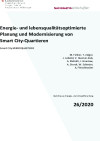
Das Projekt SC_Mikroquartiere zeigt Möglichkeiten der Stadtplanung für eine quartiersweise Entwicklung hin zu einer Low-Carbon City mit hoher Lebensqualität und guter Resilienz unter Berücksichtigung vorhandener und geplanter Gebäude, Infrastruktur und Nutzung. Das zentrale Element ist die Modellierung von Stadtstrukturen auf Mikroquartiersebene.
Schriftenreihe
26/2020
M. Fellner, T. Zelger, J. Leibold, V. Huemer-Kals, A. Kleboth, I. Granzow, A. Storch, W. Schieder, A. Fleischhacker
Herausgeber: BMK
Deutsch, 351 Seiten
Downloads zur Publikation
Plug&Play Storage of Photovoltaic Power (P3Power)
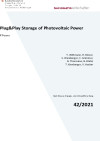
Im Projekt P³Power wird die Messtechnologie NetDetection (Abschätzung des Leistungsverbrauchs an einer Phase von einem beliebigen Messpunkt, z.B. einer Steckdose, in einem Haushalt) entwickelt. Auf Basis dieser Technologie werden plug&play Photovoltaik- und Speichersysteme realisiert, welche 100% Eigennutzung innerhalb beliebiger Aggregationsgrößen - vom Mehrfamilienhaus bis zur Gemeinde - ermöglichen ohne bestehende Installationen adaptieren zu müssen. Die Technologie wird digitalisiert, im Laborumfeld und in Realhaushalten getestet und zu einem umfassenden Energie-Service-Angebot weiterentwickelt.
Schriftenreihe
42/2021
Y. Wittmann, H. Bieser, S. Weinberger, C. Grimmer, B. Thormann, B. Böckl, T. Kienberger, V. Hacker
Herausgeber: BMK
Deutsch, 48 Seiten
Downloads zur Publikation
Energie2POG - Hybrider Energieverbund am Pogusch - Erneuerbare Energien und kosteneffizienter Betrieb
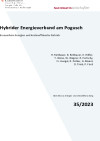
Ziel des Projektes war die Konzeption, Optimierung und Demonstration eines hybriden hinsichtlich betrieblicher Stoffströme optimierten Energieversorgungssystems für einen Gastronomie und Hotelbetrieb in exponierter Lage. Das Konzept ermöglicht die Integration und Einbindung betrieblicher Stoffströme in das Wärme- und Energieversorgungssystem.
Schriftenreihe
35/2023
H. Reitbauer, B. Reitbauer, K. Höfler, T. Weiss, W. Wagner, R. Pertschy, Fr. Hengel, R. Pichler, G. Maierl, D. Trieb, P. Fürst
Herausgeber: BMK
Deutsch, 107 Seiten
Downloads zur Publikation
PLAISIR - Planning Innovation: Lernen aus sozial innovativen Energieprojekten
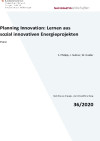
PLAISIR analysiert sozial innovative Energieprojekte in strukturschwachen Regionen um deren Rolle in regionalen Energietransitionsprozessen zu verstehen und Empfehlungen für energieorientierte, endogene Regionalentwicklung formulieren zu können.
Schriftenreihe
36/2020
S. Philipp, J. Suitner, W. Haider
Herausgeber: BMK
Deutsch, 105 Seiten
Downloads zur Publikation
The Green P - Nutzung von städtischen Verkehrsflächen für die Produktion von Biomasse
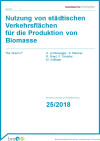
Zahlreiche Verkehrsflächen im städtischen Umfeld werden nur einen geringen Teil der Zeit tatsächlich genutzt. Inhalt dieses Projekt war, die Möglichkeit zu untersuchen, solche Flächen durch Integration von Photobioreaktoren zusätzlich zur Produktion von Biomasse zu nutzen und die Systeme möglichst vollständig in die urbanen Stoff- und Energiekreisläufe einzubinden.
Schriftenreihe
25/2018
K. Lichtenegger, K. Meixner, R. Riepl, F. Schipfer, M. Zellinger
Herausgeber: BMVIT
Deutsch, 73 Seiten
Downloads zur Publikation
Demo light Impact-Monitoring und messtechnische Untersuchung von energieeffizienten Gebäuden (DeLight Monitoring)

Das Projekt umfasst die messtechnische Untersuchung von elf innovativen Gebäuden hinsichtlich ihres Energieverbrauchs und Nutzungskomforts. Darüber hinaus werden Gebäudeerrichter und -betreiber sowie die Öffentlichkeit zum Thema energietechnische Optimierung des Gebäudebetriebs sensibilisiert und dessen Potenziale aufgezeigt.
Schriftenreihe
10/2021
P. Lampersberger, M. Wedam
Herausgeber: BMK
Deutsch, 215 Seiten
Downloads zur Publikation
Zukunftsquartier 2.0 - Replizierbare, thermisch und elektrisch netzdienliche Konzeption von (Plus-Energie-) Quartieren im dichten urbanen Kontext. Weg zum Plus-Energie-Quartier in Wien
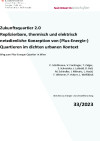
Entwicklung eines replizierbaren Konzepts zur netzdienlichen Integration von innovativen (Plus-Energie-) Quartieren mit hoher Vor-Ort- Energieaufbringung in die bestehende Netzinfrastruktur (Strom- und Fernwärmenetz).
Schriftenreihe
33/2023
P. Schöfmann, V. Forstinger, T. Zelger, S. Schneider, J. Leibold, D. Bell, M. Schindler, I. Mlinaric, L. Hackl, F. Wimmer, P. Holzer, L. Weißböck
Herausgeber: BMK
Deutsch, 212 Seiten
Downloads zur Publikation
AIA4ALL- Entwicklung von offenen, modularen und automatisierbaren Auftraggeber-Informations-Anforderungen (AIA) und BAPs
Die Auftraggeber-Informations-Anforderungen – die AIA – dient den Auftraggeber:innen (AG) dazu, Ziele und Anwendungsfälle für ein BIM-basiertes Bauprojekt zu definieren. Das Ziel dieses Projekts ist es daher, eine modulare, maschinenlesbare AIA zu erstellen und einen Prozess für die Überleitung in den BAP zu schaffen, die nahtlos in die Tool-Landschaft von openBIM-Projekten integriert werden können. Dies geschieht durch Entwicklung einer offenen Plattform zur Erstellung von Anwendungsfällen für die Auftraggeber-Informations-Anforderungen (AIA).
AIA4ALL - development of open, modular and automatable employer’s information requirements (EIR) and BIM execution plan (BEP)
The Employer's Information Requirements - EIR (German: AIA) - serves the client to define goals and use cases for a BIM-based construction project. The aim of this project is to create a modular, machine-readable AIA that can be seamlessly integrated into the tool landscape of openBIM projects. This is done by developing an open platform for creating use cases for the AIA.
Innovationslabor act4energy
Mit dem Innovationslabor act4energy wurden eine Plattform und die Infrastruktur-Voraussetzungen für die Lösung des Problems der stark fluktuierenden Verfügbarkeit von Erneuerbaren Energien geschaffen, mit Schwerpunkt auf die PV-Strom-Eigenoptimierung.
PLAISIR - Planning Innovation: Lernen aus sozial innovativen Energieprojekten
PLAISIR analysiert sozial innovative Energieprojekte in strukturschwachen Regionen um deren Rolle in regionalen Energietransitionsprozessen zu verstehen und Empfehlungen für energieorientierte, endogene Regionalentwicklung formulieren zu können.
PLAISIR - Planning Innovation: Learning form socially innovative energy projects
PLAISIR analyses social innovation in energy projects located in peripheral region in order to understand their role in energy transition processes and to give recommendations for energy-oriented, endogenous regional development policy.
P³Power - Plug&Play Storage of Photovoltaic Power
Im Projekt P³Power wird die Messtechnologie NetDetection (Abschätzung des Leistungsverbrauchs an einer Phase von einem beliebigen Messpunkt, z.B. einer Steckdose, in einem Haushalt) entwickelt. Auf Basis dieser Technologie werden plug&play Photovoltaik- und Speichersysteme realisiert, welche 100% Eigennutzung innerhalb beliebiger Aggregationsgrößen - vom Mehrfamilienhaus bis zur Gemeinde - ermöglichen ohne bestehende Installationen adaptieren zu müssen. Die Technologie wird digitalisiert, im Laborumfeld und in Realhaushalten getestet und zu einem umfassenden Energie-Service-Angebot weiterentwickelt.
P³Power - Plug&Play Storage of Photovoltaic Power
The core of the project P³Power is the measurement technology NetDetection, which is able to detect the power consumption of a household from any point, e.g. a regular wall socket. Based on this technology a plug&play powerplant, consisting of photovoltaics and battery pack, is realized. The system is able to guarantee 100% self-consumption within flexible aggregates (from single households to whole communes) without any changes of existing infrastructure. The measurement technology will be implemented into digital hardware, evaluated comprehensively in lab and household environment and subsequently new energy service business models are developed.
Innovation lab act4energy
The Innovation Lab act4energy is set up as an innovation laboratory project. Its focus is to solve the problems of renewable energies integration with a focus on photovoltaic power paired with local consumption, linked to the the high fluctuation of renewable energies.
Energie2POG - Hybrider Energieverbund am Pogusch - Erneuerbare Energien und kosteneffizienter Betrieb
Ziel des Projektes war die Konzeption, Optimierung und Demonstration eines hybriden hinsichtlich betrieblicher Stoffströme optimierten Energieversorgungssystems für einen Gastronomie und Hotelbetrieb in exponierter Lage. Das Konzept ermöglicht die Integration und Einbindung betrieblicher Stoffströme in das Wärme- und Energieversorgungssystem.
Energy2POG - Hybrid Energy Cluster Pogusch - Renewable energies and cost-efficient operation
The aim of the project was the design, optimisation and demonstration of a hybrid energy supply system as well as optimised material flows for a restaurant and hotel business in an exposed location. The concept allows the integration of material flows into the heat and energy supply system.
DeLight Monitoring - Demo light Impact-Monitoring und messtechnische Untersuchung von energieeffizienten Gebäuden
Das Projekt umfasst die messtechnische Untersuchung von elf innovativen Gebäuden hinsichtlich ihres Energieverbrauchs und Nutzungskomforts. Darüber hinaus werden Gebäudeerrichter und -betreiber sowie die Öffentlichkeit zum Thema energietechnische Optimierung des Gebäudebetriebs sensibilisiert und dessen Potenziale aufgezeigt.
DeLight Monitoring - Demo light Impact-Monitoring and metrological investigation of energy-efficient buildings
The Project consists of the metrological examination of eleven innovative buildings in terms of energy consumption and user comfort. In addition, building constructors and operators as well as the public are sensitized to the subject of energy-related optimization of building operation. Also, the potentials of energy-related optimization of building operation are shown.
